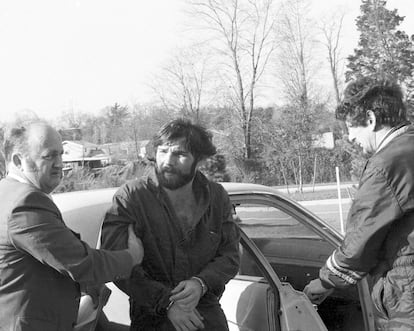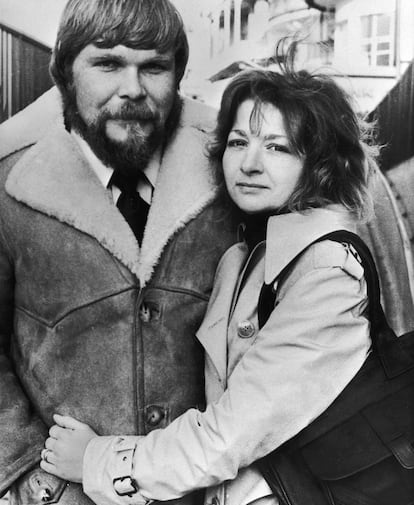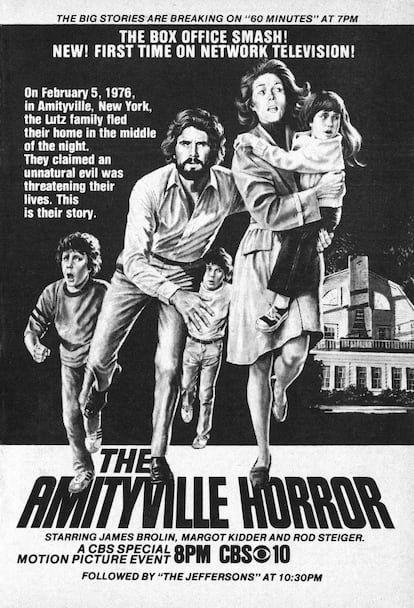The brutal truth about Amityville: It wasn’t ghosts but something worse
Thanks to fiction, 112 Ocean Avenue became the most famous ‘haunted’ house in the world. The book by Ric Osuna reveals judicial irregularities and scams that led to the legend around the notorious massacre


It is 3.15am on November 13, 1974. A 23-year-old man, Ronald DeFeo, Jr. (more commonly known as Butch), wakes up and, rifle in hand, executes his entire family: his parents, two sisters and two brothers. All died face down in bed, as if none had been awoken by the sound of gunfire, and none of them had been drugged. It was as if a supernatural force had somehow silenced the weapon and kept the six victims in a trance until their fate was sealed. This is how most of the more than 30 horror movies inspired by the patricide in the Long Island neighborhood of Amityville in New York start – from the original and most famous of all them, The Amityville Horror (1979) – to then go on and tell the story of how another family who moved into the house later experienced paranormal phenomena. These movies often carry the tagline “based on real events” because surprisingly they have some basis in reality: the original court ruling in the case, handed down in 1975, did not make explicit mention of malign spirits, but it did consider the story plausible.
In his 2002 book The Night the DeFeos Died: Reinvestigating the Amityville Murders, Ric Osuna goes over all of the irregularities surrounding the case, the obstacles the defense team encountered in gaining access to evidence that had not been submitted and the hurry on the part of the authorities to lock up a culprit even before a coherent version of events had been obtained. Osuna has for years advocated for the case to be reopened. His goal was not to see Butch DeFeo – who confessed to the crime and died in custody in March, 2021, and the age of 69 – exonerated, but that his true involvement in the killing of his family be established.
There have been question marks over DeFeo’s guilt from the moment he was arrested, given that the authorities at the time were convinced the crime had to have been carried out by more than one person. In his conclusions, Osuna maintains that DeFeo killed his parents, Ronald and Louise DeFeo, with the help of a friend, but that his younger siblings were killed by his 18-year-old sister Dawn, who was then shot by DeFeo after he witnessed the atrocity. “I think that Dawn was involved and simply saying so makes me sad, because we are talking about a girl ready to do anything to get out of the house and escape from her parents,” Osuna says via email. The author, among other arguments, points to the affidavit signed in 1974 by Dawn’s boyfriend, with whom she wanted to move to Florida despite the disapproval of her parents. He also holds up as evidence a supposedly comic song written by Dawn some time earlier, The night the DeFeos died – also the title of his book – in which she fantasized about the murder of her family.

The second half of Osuna’s book focuses on reconstructing the family life of the DeFeos, from their arrival at 112 Ocean Avenue in Amityville, which they purchased in 1965. Although the tabloid press placed a lot of emphasis on the “High Hopes” sign Ronaldo DeFeo had hung at the entrance to the house as a symbol of the prosperity he sought, 112 Ocean Avenue was far from an idyllic home according to neighbors and acquaintances Osuna interviewed. The domestic horror described to the author was centered on the violent character of Ronald DeFeo, who abused his wife and children. Furthermore, the family was directly linked to organized crime through Louise DeFeo’s father, Michael Brigante, Sr., who was an associate of Gambino crime family boss Carlo Gambino. According to Butch DeFeo – who worked alongside his father at Brigante’s dealership – and his girlfriend, they were already more than familiar with death having had to dispose of bodies on behalf of the mafia.
Although Ronald DeFeo’s erratic and reckless behavior had led the mobsters’ eyes to alight on him, Osuna rules out his involvement in the Amityville massacre since the killing of children violates the code of the Italian mafia. In the reconstruction of events laid out in his book, the events take place on November 12, after a violent argument in which Ronald DeFeo attacks his wife and several of his children leaving his youngest child, a nine-year-old, with a bloodied face. Dawn, for her part, tried to defend herself with a knife. Convinced that their father would kill them all if they did not act first, Dawn persuades her older brother, Butch, to kill Ronald during the night. She also encourages the same fate for her mother, Louise, who despite also being a victim of his abuse is seen by Dawn as “beyond hope” as she was always unconditionally on Ronald’s side.

What they don’t agree on is their younger siblings. Butch DeFeo instructs Dawn to watch their bedrooms while he and – according to Osuna’s version of events – his friend, Bobby Kelske, do away with Ronald and Louise. Dawn argues that they can’t leave any witnesses and that it would be a crime for the younger children to grow up with such trauma, so she decides to kill them too. Butch, horrified by what has happened, takes matters with Dawn into his own hands and becomes the sole surviving DeFeo.
Tragedy and farce
The bulk of Osuna’s book provides a wealth of documentation and data that at the very least casts doubt over the rigor with which the trial was conducted and how the evidence was treated. For example, in the crime scene photos, which are reproduced in the book, blood stains can be seen in places that do not add up with the story that the DeFeo’s were all killed in their beds, which serves to support Osuna’s version of events. The discovery of a bullet with a different caliber from the Marlin rifle Butch discarded after the massacre in the marital bedroom is also highlighted by Osuna. However, it is in Osuna’s chronicling of anomalies during the trial that the Amityville Case starts to deal with paranormal phenomena.
A useful gauge of the police brutality meted out during that era in Suffolk County is the astronomical confession rate during interrogation: 95%, compared to, for example, 35% in the Bronx or 20% in Kings County, Brooklyn. Osuna maintains that the confession of Butch DeFeo – an alcoholic and heroin addict – stating that he was the sole culprit, was obtained under torture. The various judges involved in the trial process rejected all evidence to that effect.

The prosecutor and the police admitted on several occasions that the crime would have required three people, and another independent investigation by retired police detective Herman Race reached the same conclusion. However, media interest in the case and personal and political ambitions of those on the side of the law prescribed swift justice, even if that meant presenting inconsistent official versions of what took place.
The Night the DeFeos Died: Reinvestigating the Amityville Murders is not designed in any way to serve as a mouthpiece for Butch DeFeo, who the author describes as a “liar.” Any direct quotes from DeFeo are always verified (or discredited) by other sources when there is no evidence to support them. The newest revelations to emerge are those of his wife at the time of the crime, Geraldine DeFeo, with whom he had a daughter. DeFeo filed a suit against Osuna and his ex-wife for slander after the publication of the book and denied having ever been interviewed by the author, but he lost the trial. “Butch wanted money and royalties. Frankly, I didn’t think that he should profit for his role in the killings,” Osuna tells EL PAÍS. “Geraldine had no part in the extorsion and refused money, as such Butch also denied that she had ever been his wife. In the end, with the exception of the abuse, Butch wound up turning into his father in the way that he treated those around him.”

Butch DeFeo was not the first person or the last to view the horrific loss of six human lives as a business opportunity. His lawyer, William Weber, in desperation due to being repeatedly denied access to evidence, in a scheme worthy of the series Better Call Saul, took part in the organization of the infamous demonic haunting plot at the house in Amityville. According to Geraldine, Weber hoped to use it in Butch DeFeo’s favor during the trial. To carry out the plan, Weber formed a partnership with the next occupants of 112 Ocean Avenue, the Lutz family, who through Jay Anson’s 1977 bestselling novel The Amityville Horror described the supernatural experiences they had lived through during the 28 days they said they spent in the house. A priest was added to the cast, who was later defrocked by his diocese, as well as the well-known demonologist husband and wife team of Ed and Lorraine Warren, who held a séance during which they captured a photograph of a “demonic boy,” who looked remarkably similar to one of their photographer’s own children.
Lorraine Warren herself makes an appearance in the 2012 documentary My Amityville Horror, which focuses on the testimony of Daniel Lutz, one of the Lutz family children during their stay at 112 Ocean Avenue. In the scene, which will not be swiftly forgotten by anyone who has seen it, Warren displays a fragment of what she says is the true cross on which Jesus Christ died and a box containing hairs from the head of Saint Pius of Pietrelcina, while reciting prayers with Lutz. Unlike other works of fiction, the forest can be seen for the trees, and in the testimony of Lutz, who is convinced he witnessed paranormal phenomena as a 10-year-old, lurks the shadow of coercion and, above all, parental abuse. “In my opinion, the Lutz children were disgracefully used as part of a scam and that must have affected them in a serious way,” says Osuna, whose initial interest in Amityville led him, before his investigation, to maintain a business relationship with the father of the family, George Lutz.

In his book, Osuna recalls the moment he lost all faith in Lutz, when he was told: “Clearing up what happened isn’t as important as making more money with sequels.” Lutz also took the author to court for his description of the haunting scam in the book and, as was the case with Butch DeFeo, lost the suit. After his extensive investigation – during which he says he was the subject of several anonymous threats that ceased after the publication of The Night the DeFeos Died – Osuna, a former fan of the Amityville mystery, admits he has not been able to watch any of the slew of movies about the supposedly haunted house. “Before learning the truth, I thought the earlier ones were entertaining, but now I don’t like them. The book and the movie of The Amityville Horror capitalized on a genuine tragedy, the murders of the DeFeo family, and seduced the imagination of a public who unfortunately don’t care how they are entertained.”
Although Butch DeFeo and George Lutz are now dead, pilgrimages to 112 Ocean Avenue by people curious about the famous case continue, much to the weariness of the various families who have lived there since the events of 1974 and who have stated they have never experienced anything paranormal or demonic. In 2022 alone, three straight-to-DVD releases based on the Amityville case are slated for release: Amityville Uprising, Amityville Bigfoot and Amityville Karen.
Tu suscripción se está usando en otro dispositivo
¿Quieres añadir otro usuario a tu suscripción?
Si continúas leyendo en este dispositivo, no se podrá leer en el otro.
FlechaTu suscripción se está usando en otro dispositivo y solo puedes acceder a EL PAÍS desde un dispositivo a la vez.
Si quieres compartir tu cuenta, cambia tu suscripción a la modalidad Premium, así podrás añadir otro usuario. Cada uno accederá con su propia cuenta de email, lo que os permitirá personalizar vuestra experiencia en EL PAÍS.
¿Tienes una suscripción de empresa? Accede aquí para contratar más cuentas.
En el caso de no saber quién está usando tu cuenta, te recomendamos cambiar tu contraseña aquí.
Si decides continuar compartiendo tu cuenta, este mensaje se mostrará en tu dispositivo y en el de la otra persona que está usando tu cuenta de forma indefinida, afectando a tu experiencia de lectura. Puedes consultar aquí los términos y condiciones de la suscripción digital.
More information
Archived In
Últimas noticias
Maduro pleads not guilty before the federal court in New York: ‘I am still the president of Venezuela’
A new test can detect Alzheimer’s from a finger prick
UN team enters Sudanese city of El Fasher after paramilitary massacre: ‘It’s like a ghost town’
A recipe for resistance: Indigenous peoples politicize their struggles from the kitchen
Most viewed
- Gilles Lipovetsky: ‘If you want to live better and fall in love, take Prozac, don’t look to philosophy’
- Alain Aspect, Nobel laureate in physics: ‘Einstein was so smart that he would have had to recognize quantum entanglement’
- Alvin Hellerstein, a 92-year-old judge appointed by Bill Clinton, to preside over Maduro’s trial in New York
- Why oil has been at the center of Venezuela-US conflicts for decades
- Maduro’s downfall puts China’s relationship with Venezuela to the test









































